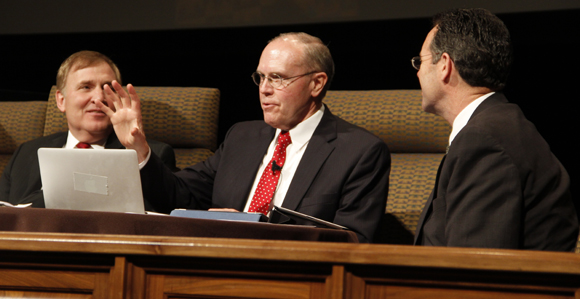Sunday School Leaders Have Broader Responsibilities, More Resources
Contributed By By R. Scott Lloyd, Church News staff writer

Sunday School general president Russell T. Osguthorpe (center) and his two counselors, David M. McConkie (left) and Matthew O. Richardson (right), make comments at the training session for stake and ward Sunday School leaders April 3.
“Learning and teaching in a gospel setting is after the way the Savior has modeled and the way that He continues to model.” —Brother David M. McConkie of the Sunday School general presidency
Related Links
Today’s Sunday School presidencies, expected to serve as specialists in ward and stake efforts to help improve gospel learning and teaching, have much broader responsibilities than in the past, and resources are in place to help them fulfill those responsibilities.
That seemed to be an overarching theme in the spring 2013 auxiliary training for Sunday School officers. Held April 3 in connection with general conference, the training emanated from the Conference Center Theater in Salt Lake City and, like the training meetings for other auxiliary organizations, was streamed live via the Internet to viewers in far-flung areas. It is available at https://www.churchofjesuschrist.org/broadcasts/auxiliary-training.
Brother Russell T. Osguthorpe, Sunday School general president, and his two counselors, Brother David M. McConkie and Brother Matthew O. Richardson, were joined by the six members of the Sunday School general board in a panel discussion. It was augmented by the showing of selected videos from the Leadership Training Library accessible on the Church’s website, ChurchofJesusChrist.org, and by resources that are part of Come Follow Me, the new curriculum for youth Sunday School, Aaronic Priesthood, and Young Women classes.
Internet viewers were invited to send comments and questions via text messaging, and several of these were read as part of the discussion.
Regarding the need to be prepared spiritually to teach, Brother McConkie quoted an introductory message from the First Presidency in the “Teaching in the Savior’s Way” guidebook. “The most important part of your service will be your own daily spiritual preparation, including prayer, scripture study, and obedience to the commandments. We encourage you to dedicate yourself to living the gospel with greater purpose than ever before.”
Brother Osguthorpe said, “‘Teaching in the Savior’s Way’ is not just for those who are teaching. It is for all of us who are teachers as leaders and teachers.”
Brother McConkie added that such teaching is not new. “Learning and teaching in a gospel setting is after the way the Savior has modeled and the way that He continues to model,” he said.
A video was shown featuring a Mormon Channel conversation between Brother Osguthorpe and Elder David A. Bednar of the Quorum of the Twelve. Elder Bednar quoted a Book of Mormon passage saying that the Holy Ghost carries a message “unto the heart.”
“It’s significant to me that it doesn’t say ‘into the heart’; it’s ‘unto the heart,’” Elder Bednar pointed out. A teacher cannot force a testimony into a person’s heart, he said. What has to happen for it to get inside is that the person has to act in faith according to the truth, “and that’s how it goes from ‘unto’ to ‘into.’”
Board member Karl R. White said one thing he notes in observing Sunday School classes is the percentage of time the teacher spends lecturing versus inviting to action. “It’s a very, very small percentage, in fact, as lots of classes never have an invitation to action.”
Board member Brad Wilcox said that, unlike a general meeting such as sacrament meeting or general conference, a teacher in a classroom setting has the chance to follow up on such invitations to action and “to help that young person or child say, ‘Wow, I did it! This is how it feels.’”
Board member Amy White said, “The worst part of teaching is a ‘talking head.’” She related an experience she and her husband, Karl, had the previous evening in their home reading scriptures with two of their grandchildren. She said she resisted the temptation to be a talking head. Instead she allowed them to ask questions about what they were reading and then to explore their own thoughts in response to those questions.
“The Holy Ghost can help everyone participate if the person up front will be quiet and let the Holy Ghost do His work,” she said.
Board member Ann Madsen said she has found that class members, guided by the Holy Ghost, often will have answers that she herself does not have. She said in her teaching she has asked students to write down the comments they have made so that she will have a record of them. This helps them feel they have something to contribute, and they are eager to listen and see what other contributions they can make.
Board member Omar Canals said an important benefit of allowing class member participation is that it enables a teacher to prepare his or her next lesson based upon the knowledge and needs of the class members.
Speaking of the new Come, Follow Me curriculum, board member Lee Tom Perry said teachers are apt to hear more of two different things: a “delightful buzz” as class members interact in pairs and small groups discussing the point of the lesson, and a silence as the class members ponder those points and gather their thoughts as they prepare to contribute to the discussion.
